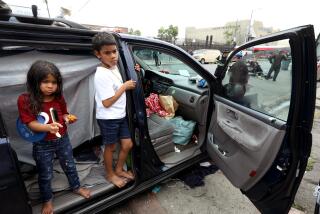Busing Fails to Ease Load on Schools : Education: More than 20,000 students are still transported from neighborhood campuses because of overcrowding. Measures opened seats in district, but few in areas hit by enrollment growth.
Despite taking measures last spring to increase classroom space at 109 elementary schools, the Los Angeles Unified School District is still busing more than 20,000 students from overcrowded neighborhood campuses, the school board was told Thursday.
The plan to ease overcrowding generated 17,526 additional elementary seats in the district this semester by putting 64 schools on year-round schedules and letting another 45 add portable classrooms or increase class sizes.
But few of those seats were in the neighborhoods hit hardest by enrollment growth this fall, meaning the 625,000-student district must continue to bus its overflow students to suburban-area schools with empty seats.
Gordon Wohlers, head of the district office that coordinates use of classroom space, told the board that 6,000 students who were bused last year were able to return to their neighborhood schools this fall because the overcrowding plan gave the district twice as many available elementary seats as last year.
But, he said, if the board does not take more drastic steps to create space at all elementary, junior and senior high schools, another 24,000 students will be crowded out of their local schools and onto buses in the next three years.
Wohlers predicted that ultimately all 600 district schools will have to operate year-round, multitrack schedules to accommodate enrollment growth estimated at about 15,000 students per year. âWe see that as an inevitability,â he said.
Currently, 170 district schools operate year-round, most of them on multitrack calendars which divide students into groups with staggered attendance schedules.
Multitrack plans generate about one-third more classroom space because one group of students is always on vacation. Such plans have been used by the district since 1974, but remain controversial because of criticism by parents who fear families and friends would be split by different schedules.
Last spring, the board voted to put all the districtâs schools on a year-round schedule by 1991. Classes would begin at most schools in mid-August and last through the end of June, with a six-week mid-winter break. All students would attend at the same time. Most schools would likely not have to convert to multitrack until districtwide enrollment outstrips available seats, which could happen by 1993.
âWeâve got to start planning for that now because if we donât, weâre going to be up against a rock in three years,â said board member Mark Slavkin.
Beginning next month, the board will consider a series of options aimed at increasing capacity at all the districtâs schools, including converting some schools to multitrack and adding more portables to others.
The focus has shifted from getting students into their neighborhood schools to merely finding enough space to seat them anywhere in the district. The district has been hamstrung by funding constraints in efforts to build new schools and faces unrelenting growth in its most overcrowded areas. It has become clear, Wohlers said, that some of the districtâs children will never have the chance to attend their neighborhood schools.
âI donât really see where the answer is going to come from,â said board member Roberta Weintraub.
More to Read
Sign up for Essential California
The most important California stories and recommendations in your inbox every morning.
You may occasionally receive promotional content from the Los Angeles Times.










